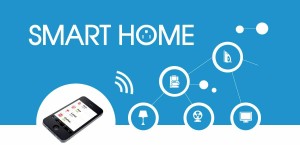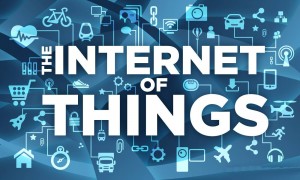For the past three decades, we’ve been hearing forecasts of smart homes that will respond to our every need. The list of over-promised features includes such things as smart refrigerators that will order what you need from the grocery store, lighting that automatically turns on or off when you enter or leave a room, heating and cooling that adjusts itself constantly to your desires and even robot butlers.
Fantasy? Perhaps, but your smart phone actually is bringing the smart home future to you now. There are now ways to control every aspect of your nest from your palm, from how bright your bedroom is to how much energy you use every month.
 Here are some of the ways you can control your home today, whether you’re there or not.
Here are some of the ways you can control your home today, whether you’re there or not.
Music that follows you around. It now is easier than ever to throw what you’re listening to from your phone to your home speakers – even if those speakers aren’t internet-enabled. You probabaly have heard of Sonos, one of the market-leading connected speaker systems, and they undoubtedly put out beautiful high-quality sound with seamless syncing around the home. But, with speakers starting from US $199, it’s an expensive solution – and there are now much cheaper options providing you have some speakers already.
Gramofon is a classy-looking box that connects your speakers to your WiFi for US $69 and you can link them together to play the same or different music across your house using Qualcomm AllPlay. Similarly, Google’s Chromecast Audio is a smaller version of the same idea, though it can’t be wired into your home network with ethernet like the Gramofon.
There’s also the ingenious Vamp, which lets you turn any passive hi-fi speaker into a Bluetooth one – the tiny red box plugs into your normal black and red connections on the back of any speaker and even provides the power. With Vamp you could rescue any ancient working speaker and make it smart for about $60.
Appliances that do the hard work for you. Tea lovers’ dreams have come true with the iKettle (US $180), a Wi-Fi enabled kettle that you can turn on from your phone. It tells you when the water’s boiled and even keeps it warm until you get there. Th iKettle can send a message to your phone first thing in the morning or when you arrive home after a long day, asking if you’d like to turn the kettle on so the water will be boiled by the time you make it to the kitchen. The same firm also makes a connected coffee maker if that’s your caffeinated beverage of choice.
Other appliances are seeing similar features added, too. Forgetting to press “go” on the washing machine as you’re heading out the door ceases to be a problem with connected washers, which can be controlled from an app on your phone. Most manufacturers now offer this, with laundry apps from brands like LG and Samsung even diagnosing technical problems with your machine and telling you how to fix them without calling a repairman.
In fact, everything from your oven to your dishwasher can be controlled from your phone with appliance ranges like Hoover’s Wizard. Whether you want to ask how much cooking time’s left on your food, get an alert when your chilled drink’s reached ideal temperature or just remotely switch on the cooker hood light, it’s all a tap away. LG’s taken things even further with the LG Homechat, which lets you text your appliances.
Homechat responds to commands like “monitor all products,” (gives you a status update), “going to bed” (stops music after 10 minutes), and Siri-style “what is this song?” inquiries. It’s as zany as it sounds, but as AI and language processing improve, natural conversation will be the way we interact with everything.
While we’re waiting for robot butlers, we do at least have robot vacuums. Neato’s BotVac can be controlled not only from your phone but from your smartwatch too – Apple or Android. Cost is around $800 US.
Stopping the worries when out and about. What about forgetting to turn things off, such as the iron, hair rollers, the heating or air conditioning? All these things and more can be controlled from the cloud.
The Heat Genius system allows you to turn the heating and hot water on and off from a smartphone app, and even lets you control and schedule room heating individually. Similarly, Google has raised temperatures by buying out Nest and offering the Learning Thermostat through the Google Play store, alongside the Nest Cam home security camera and Nest Protect smoke alarm.
Nest products work seamlessly with each other, connecting to a range of third-party smart home tech including Philips Hue lights and Whirlpool washers. It’s an Apple-like approach, encouraging people to look out for the “Works With Nest” logo before making a purchase – much like the “Designed for iPhone” badge Apple uses.
The Nest range is facing tough competition from tado, though: a heating system that claims to pay for itself within a year. It uses your smartphone location to automatically turn the heating off when everyone’s left the house then turn it on again when someone comes back.
Smart plugs are the anxious user’s best friend, letting you check something’s switched off when you’re not at home. Belkin’s WeMo and D-Link’s Home Smart are two of the many branded versions of this handy product. Smart plugs can switch anything on or off from your phone.
Ambience and Security. The new connected showerhead from French firm Start & Blue uses Bluetooth to connect to an app that lets you set your ideal shower length. LED lights on the Hydrao Smart Shower then change from green through to amber and red to tell you when you’ve used too much water.
Systems like Philips Hue and LIFX have made a huge splash with their smart lightbulbs, which let you turn your lights on or off and change the colour with your phone or tablet. Other apps sync your lighting with the beat of your music or flash when you’ve been tagged in a Facebook photo. Wearables company Misfit has also taken on the smart bulb market with Bolt, a connected bulb that, can be controlled through your phone or, for extra futurism, by tapping on Misfit’s fitness wristbands
The Bolt isn’t the only smart bulb to do more than light up a million colors, either: the latest round of products can also boost your WiFi signal (Sengled Boost Wifi Bulb), and even play music (Mipow Playbulb).
You can put a Roost smart battery in your home fire alarm. The WiFI-enabled 9V battery hooks your alarm up to the cloud so it can tell your phone when your fire alarm’s blaring and you’re not there.
Despite the array of products noted above, the market is still pretty fragmented. In the future, products from disparate manufacturers may work together harmoniously. The future of smart homes isn’t just appliances talking to you, but talking to each other. Your washing machine vould let the dishwasher know it’ll be using the hot water for a while, your oven mighjt the ventilation fan know it’s burnt the chicken and might need some help with ventilation.









